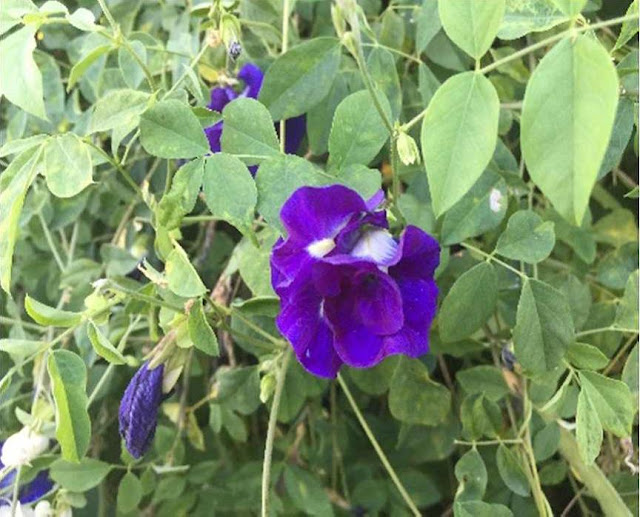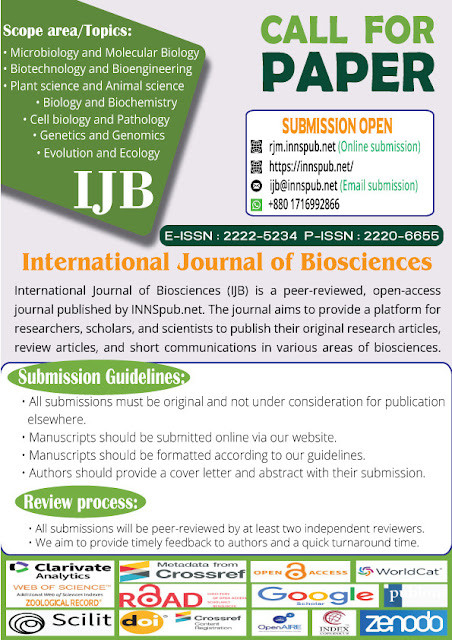Ma Chrischelle F. Bullecer, from the different institute of the Philippines. wrote a research article about, Clitoria Ternatea Flower Extract: An Alternative to Methylene Blue Stain. entitled, Potential of Clitoria ternatea L. flower extract as a safe and effective alternative to methylene blue stain. This research paper published by the International Journal of Biosciences| IJB. an open access scholarly research journal on Biology, under the affiliation of the International Network For Natural Sciences | INNSpub. an open access multidisciplinary research journal publisher.
Abstract
The efficacy of Clitoria ternatea L. flower (Pukingan) aqueous extract for use in staining cheek
cells was studied to obtain non-toxic, environmentally friendly and low-cost
dyes for use in staining. C. ternatea L. has a sparsely pubescent
stem that sub-erect and woody at the base and may be up to 5 m long. The flower
extract of C. ternatea L. have anthocyanins which are categorized as
ternatins. A number of histological techniques have been identified to be used
to provide a nuclear stain consist of natural phenolic compounds, structurally
related to anthocyanins. The objective of this study is to determine the
efficacy of aqueous extract of Pukingan on cheek cells considering several
parameters. Dye extracts from C. ternatea L. were used to stain
cheek cells using the existing standard staining procedures with little
modification. One Way Analysis of Variance was used to analyze differences
among the mean scores. A significant difference was determined using a post hoc
analysis which is Tukey’s test using SPSS and the level of significance was set
at 0.05. From the results of the descriptive, parameters for all sample
populations have almost similar interpretations. The nucleus was stained
satisfactorily, and the sharpness and contrast were excellent. The cytoplasm of
the cheek cells was stained intensely, and the stained areas are homogeneous.
The prepared extracts had affinity for the cell membrane and nucleus.
Therefore, this study shows that dye extracts from C. ternatea L. could
be used for cheek cell staining as alternative to Methylene blue stain.
Read more : Trianthema Portulacastrum: Nourishing Apis florea Colonies in Dearth | InformativeBD
Introduction
The complexity of tissue can be observed in the varied shapes, sizes, and arrangements of cells, and stains are advantageous in revealing these details and more (Nguyen, 2017). Dyes and stains are commonly used in biology to highlight cellular structures in different tissues. While microscopes allow for the magnification of minute anatomical features, dyes provide a clearer and more emphasized view of the specimens. Staining can also be used to highlight metabolic processes or differentiate between live and dead cells, and to enumerate cells to determine biomass in a given environment. Methylene blue is the preferred stain for animal cells, and is often used to view cheek cells in laboratory settings. However, it is toxic when ingested and causes skin and eye irritation (Chew Weng Cheng et al., 2014). Plant extracts are a potential source of natural dyes that produce varying color intensities from yellow to red to black, and are safe for users and the environment due to their herbal and organic nature.
The Clitoria ternatea L., also known as butterfly pea or Pukingan, is a tropical legume that can grow vigorously as a trailing, scrambling, or climbing plant. Its stems are sub-erect and sparsely pubescent, and may be woody at the base, reaching up to 5 meters in length. The plant only roots at the tips of its stems, according to studies by Cook et al. (2005) and Staples (1992). The leaves are pinnate, with 5-7 elliptical leaflets that are about 3-5 centimeters in length. The flowers are typically solitary or paired, with a diameter of about 4 centimeters and can be either deep blue or pure white in color.
Generally, this study aims to determine the efficacy of aqueous extract of Pukingan (Clitoria ternatea) aqueous extract on cheek cells. Specifically, this study aims to compare the mean staining scores of cheek cells stained with: (1) Stain 1, 5gram Pukingan flower/150ml distilled water subjected to 5minute boiling (2) Stain 2, 5gram Pukingan flower/150ml distilled water subjected to 10minute boiling (3) Stain 3, 10gram Pukingan flower/150ml distilled water subjected to 5minute boiling and (4) Stain 4, 5gram Pukingan flower/150ml distilled water subjected to 10minute boiling based on the following parameters: Nuclear staining; Nuclear Detail; Cytoplasmic staining and Uniformity of Stain.
Since many synthetic dyes pose a hazard to the health of students and those who prepare them, this study also aims to make use of a natural alternative to Methylene blue stain. Roots, Fruits, leaves and flowers from dye-producing plants can hypothetically provide an effective stain. An abundant number of potential plants with staining properties sprout throughout the Philippine setting, and one of them is Clitoria ternatea L. (Pukingan). The Fabaceae family in general has anthocyanins, which are water-soluble, vacuolar pigments capable of staining cellular structures. Therefore, Clitoria ternatea L. (Pukingan) presents a promising alternative as a non-toxic, accessible and cost-efficient organic chemical stain.
Reference
Chew Weng C, Abdullah
R, Saad S. 2014. Alternative staining using extracts of hibiscus (Hibiscus
rosa-sinensis L.) and red beet (Beta vulgaris L.) in diagnosing ova
of intestinal nematodes (Trichuris trichiura and Ascaris lumbricoides) 1, 14-18
Cook BG, Pengelly BC,
Brown SD, Donnelly JI, Eagles DA, Franco MA, Hanson J, Mullen BF, Partridge IJ,
Peters M, Schultze-Kraft R. 2005. Tropical forages: an interactive tool
[CD-ROM]. CSIRO, DPI & F (Qld), CIAT and ILRI, Brisbane, Australia
Eom S, Shin D, Yoon K,
Indan J. 2001. Fibre Text 26(4), 425-421.
Mistry TV, Cai Y,
Lilley TH, Haslam E. 1991. Polyphenol interactions. Part 5 Anthocyanin
co-pigmentation. J Chem Soc, Perkin Trans 2(8), 1287-1296.
Nguyen D. 2017.
What Is the Advantage of Using Stains to Look at Cells? Sciencing.com.
Copyright 2017 Leaf Group Ltd. All Rights Reserved. Leaf Group Education
Onslow MW. 2013.
The Anthocyanin Pigment of Plants. Google Books. Page 32. Retrieved from:
www.books.google.com.ph/books
Staples IP. 1992. Clitoria
ternatea L. In. T Mannetje L and Jones RM. Plant Resources of South-East
Asia. 4. Forages Pudoc Scientific Publishers, Wagening. The Netherlands pp.
94-96
Vidana Gamage GC, Lim
YY, Choo WS. 2021. Anthocyanins From Clitoria ternatea Flower:
Biosynthesis, Extraction, Stability, Antioxidant Activity, and Applications.
Front. Plant Sci. 12, 792303. DOI: 10.3389/fpls.2021.792303
Webb MR, Min K, Ebeler
SE. 2008. Anthocyanin Interactions with DNA: Intercalation, Topoisomerase
I Inhibition and Oxidative Reactions. J Food Biochem 23, 32(5), 576-596.
DOI: 10.1111/j.1745-4514.2008.00181.x. PMID: 19924259; PMCID: PMC2778027.
Source : Potential of Clitoria ternatea L. flower extract as a safe and effective alternative to methylene blue stain











%20in%20full.JPG)


0 comments:
Post a Comment